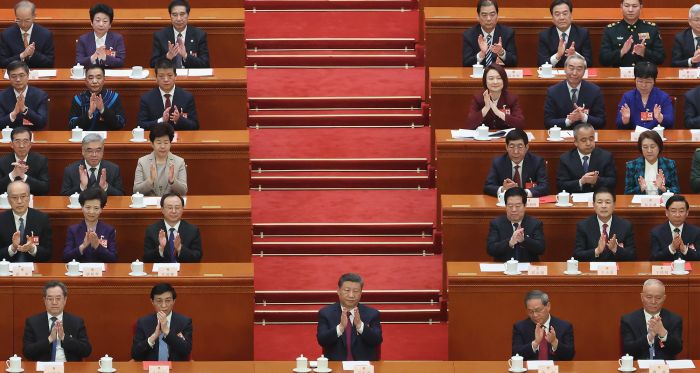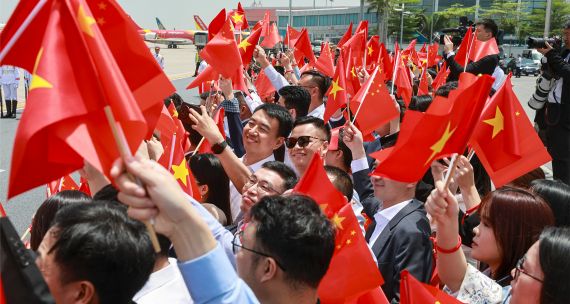La version française est à venir.
On March 11, China concluded its annual 'Two Sessions' — a pair of legislative and advisory meetings focused on Beijing's economic priorities for the year ahead. The slew of macroeconomic measures announced at those meetings are now taking on heightened significance amid the escalating U.S.–China trade war.
Facing unprecedented U.S. tariffs of at least 145 per cent, the Chinese Communist Party (CCP) is preparing for a protracted confrontation. The measures announced at the Two Sessions — including boosting domestic consumption, stabilizing the property market and local governments’ finances, addressing youth unemployment, and creating a friendlier environment for private businesses and foreign investment — are designed to cushion the immediate blow of American tariffs.
Amid the dramatic escalation in the trade war over the past two weeks, China’s top leaders have expressed confidence that the country’s economy is well prepared to “hedge against adverse external impacts.” However, while the policies announced at the Two Sessions, and in the weeks since, may help to mitigate short-term shocks, meeting China’s primary economic objectives without addressing deeper structural issues, including low consumer confidence, will be extremely challenging. Furthermore, some of China’s economic objectives conflict with the CCP’s broader political agenda; for example, while the CCP seeks to rein in the private sector, it also wants these firms to drive innovation and improve productivity.
Still, China is better placed to weather a protracted trade conflict with the U.S. today than it was during the first Trump administration. China is also still committed to its longer-term objective of becoming the world’s number one economy and the new leader of the multilateral trading system. However, China’s credibility to helm the global trading system hinges on whether it is able to boost domestic consumption to absorb its manufacturing output. If China does not succeed in doing so, it will likely redirect exports intended for the U.S. to other markets, to the irritation of some of its trading partners, some of whom are already frustrated with Beijing for subsidizing its domestic producers and dumping excess goods into their markets.
Juggling Policy Priorities
In response to the Trump administration’s escalating levies, Beijing expressed its willingness to take “extraordinary measures.” On April 11, China retaliated with a 125 per-cent tariff on American goods. Some policy decisions announced at the recent Two Sessions create space for Beijing to use stimulus measures and other policy tools. For example, the central government vowed to raise the budget deficit to its highest level in over three decades (4% of GDP) to pump up government spending. An easing of monetary policy could also be “readily deployed” to help shore up lending, consumption, and the broader economy, and fiscal deficits could be expanded through the issuance of various government bonds. Leaders will also seek to support businesses hardest hit by the tariffs, such as helping them reduce their reliance on U.S.-bound exports, either by exploring opportunities at home or in alternative markets, most notably the Association of Southeast Asian Nations and Belt-and-Road countries.
The top priority, however, will be to boost domestic consumer demand. Currently, domestic consumption in China hovers at around 40 per cent of GDP — well below the international average of 60 per cent. Since summer 2024, Beijing has launched initiatives to encourage consumer spending, such as doubling bond issuance to support a consumer goods trade-in scheme that now amounts to C$57.3 billion (300 billion yuan). Under this scheme, Chinese consumers receive a subsidy when trading in older appliances, digital products, and electric vehicles for newer models. Other measures include promoting income growth and adjusting the minimum wage to address regional income disparities. Meanwhile, the government has pledged to bolster sectors such as real estate, pensions, elderly care, childcare, and support for vulnerable populations — all in the hopes of persuading cautious consumers to redirect savings toward everyday purchases.
However, short of direct income redistribution, such as the cash transfers that many economists have called for, these measures may yield only modest results. Ultimately, boosting household spending will hinge on citizens’ ability to find better employment and earnings prospects. As of March, urban youth unemployment for the 16-24 age group has remained high at 16.5 per cent (according to official statistics, with independent assessments putting the number much higher) — a situation that could worsen with 12.2 million new college graduates expected to enter the job market in the coming months. In addition to creating more entrepreneurship and training opportunities for these youth, the Two Sessions confirmed that there would be better protections for the rights of workers in ‘flexible’ employment and the gig economy, which continues to grow and currently absorbs 23 per cent of the country’s workforce.
To help resolve the mismatch between jobs and skills, Chinese policymakers seem to be pinning their hopes on accelerating labour-intensive advanced manufacturing and have emphasized skills training to meet the demand in the high-tech and critical sectors. However, this requires walking a fine line between promoting industrial upgrades — which will eventually replace a significant number of human workers with automation — and keeping its population sufficiently employed.
Giving the Private Sector a Green Light?
To signal that the CCP is willing to reverse its years-long regulatory crackdown on the private sector, Chinese President Xi Jinping hosted a meeting in February with the leaders of China’s tech giants. The event was meant to be both a rallying cry and to provide assurance that the central government will support free market competition and solve firms’ financing difficulties by making capital more accessible.
The official message was clear: China needs its private businesses to play a role in helping the Chinese economy scale the value chain and overcome trade adversities. Cheered by DeepSeek’s recent AI breakthrough, policymakers in Beijing seem confident that if managed properly, China’s high-tech innovators can evade ever-more stringent U.S. restrictions and emerge as major global competitors.
There is uncertainty, however, on whether or how much the CCP is willing to loosen its grip. While Xi reiterated that support for the private sector is “unwavering” and “unchangeable,” skepticism lingers about whether the current regulatory environment will be subject to change, especially if authorities see the expansion of certain firms as risking national security or as an example of ‘disorderly capitalism’ that conflicts with the CCP’s “common prosperity” goals. Policy promises could also wane when being implemented at the local level and in each sector. As a result, China’s private sector players are likely to continue exercising caution in navigating these unspoken rules.
Finally, another priority for restoring business and investor confidence will be stabilizing the capital market and narrowing losses. Authorities in China responded quickly to the tariff-fuelled market turmoil, with major state-linked funds stepping in to increase their holdings, and top financial regulators loosening investment and lending rules. While these measures have calmed markets temporarily, further interventions may be necessary if the ‘tit-for-tat' tariff dynamic persists.
China’s Trade Playbook as External Pressures Mount
Beyond the immediate challenge of managing its domestic economy, Beijing is also seeking to reposition itself on the global stage. With Washington’s retreat from leading the global trading system, Beijing aims to portray itself as a responsible global power — one that “safeguards the multilateral free trade system” while leading efforts to counter global trade disruptions.
Chinese leaders at the Two Sessions also talked about deepening and building partnerships, such as through actively pursuing membership in the Comprehensive and Progressive Agreement for Trans-Pacific Partnership (CPTPP), of which Canada is a member. The CCP is also working to draw Europe closer to its economic orbit despite European concerns over China’s unfair trade practices and worries about redirected Chinese exports. The European Commission has proposed setting up a trade diversion-tracking mechanism, which would monitor developments in trade patterns caused by U.S. tariffs, especially in sectors such as automobiles where there are Chinese overcapacity concerns. The two sides have also begun negotiating setting minimum prices on Chinese-made electric vehicles to potentially replace the tariffs introduced by the EU in 2024.
The dilemma in China’s trade policy is thus balancing the temptation (and perceived need) to divert its surplus exports to markets outside of the U.S. while also not alienating important trading partners who may see such moves as harming their domestic manufacturing. This dilemma could prompt policy debates among CCP decision-makers, especially if other countries take action against what they see as China’s dumping of overproduced goods, including whether Beijing should hit back hard with retaliatory measures.
Conclusion
At the Two Sessions, China’s leaders recognized the need to take concrete actions to recalibrate the country’s economic model in the face of escalating tariffs that threaten its traditional engine of growth: exports. The latest tariff developments underscore the necessity of having a strong internal demand and make the timeline even tighter for Beijing’s stimuli to work.
With the current tit-for-tat tariff dynamic, China needs to make a more decisive pivot towards a consumption-driven growth model. This would require, however, the CCP to take more dramatic actions beyond what has been recently announced.
Overall, China’s ability to successfully spur consumption will hinge on higher disposable incomes, which in turn depends on a strong private sector that can offer high-quality jobs. Solving these interlinked challenges amid the need to handle near-term shocks will test Chinese policymakers’ ability to make sure priorities are implemented across the country’s vast domestic market they hope to capitalize on.
• Edited by Erin Williams, Senior Program Manager, and Ted Fraser, Senior Editor, APF Canada






